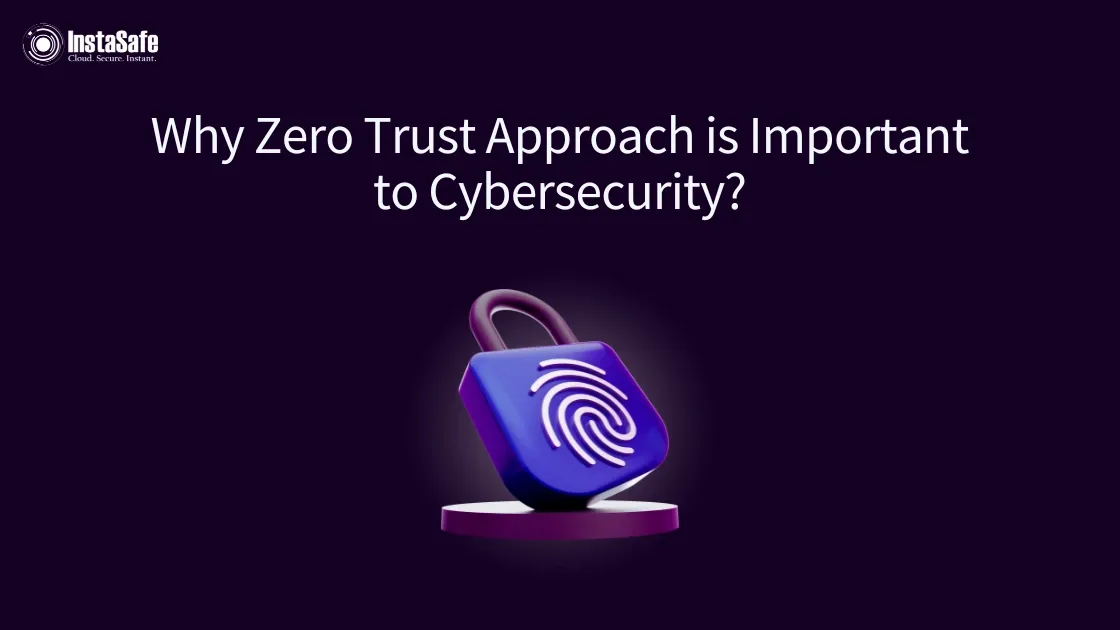Why Zero Trust Approach is Important to Cybersecurity?

As the years have gone by, the digital world has changed a lot, making it harder for businesses to keep their important data and processes safe. Traditional security methods that focus on building strong walls around networks are no longer sufficient.
This is where the zero-trust approach comes into the picture. It is a revolutionary security technology that is drastically changing how organisations defend their digital assets.
Let’s understand why the zero-trust approach is important to combat cyber threats.
Understanding the Zero Trust Approach
The zero-trust security model operates on a simple yet powerful principle: "Never trust, always verify." Unlike traditional security measures that focused on creating strong perimeters and assuming everything inside was safe, the zero-trust approach treats every user, device and connection as potentially compromised.
The concept gained prominence when security professionals recognised that many breaches occurred not from outsiders breaking in, but from trusted insiders or compromised credentials moving freely within networks. The zero trust security framework assumes that threats exist both outside and inside organisational boundaries.
Why Traditional Security Falls Short?
Conventional security relied heavily on perimeter defence – similar to a castle surrounded by a moat. Once someone crossed the drawbridge, they could move freely within. This model worked when networks had clear boundaries, and most employees worked from corporate offices on company-managed devices.
The reality today looks very different:
- Remote and hybrid work arrangements have become standard.
- Cloud services store critical data outside traditional network boundaries.
- Personal devices frequently access company resources.
- Business partners and third parties require access to systems.
- IoT devices connect to networks in unprecedented numbers.
These factors have fractured network perimeters and expanded attack surfaces dramatically. When the boundary between "inside" and "outside" becomes blurred, perimeter-focused security cannot adequately protect organisational assets.
Core Elements of Zero Trust Security
Identity and Access Management (IAM)
Central to the zero trust approach is strict verification of who requests access. Modern IAM solutions incorporate the following:
- Strong Authentication - Moving beyond simple passwords to multi-factor authentication.
- Dynamic Permissions – Adjusting access rights based on user location, device security status and data sensitivity.
- Continuous Verification – Regularly re-authenticating users during sessions.
- Strict Access Controls – Providing users only what they need through the least privilege principles.
Zero Trust Network Access (ZTNA)
The zero-trust security framework transforms how network resources are accessed:
- Each access request faces rigorous evaluation regardless of the source.
- Applications receive protection whether deployed on-premises or in the cloud.
- Authentication processes remain transparent to legitimate users.
- Every connection undergoes security evaluation before its establishment.
Micro-segmentation
Breaking networks into isolated, smaller zones restricts movement and limits damage from breaches:
- Network resources are divided into protected segments.
- Threats cannot easily move laterally through systems.
- Each segment requires separate authentication.
- Critical assets gain additional protection layers.
Real-World Benefits of Zero Trust
Reduced Attack Surface
By limiting access rights and verifying each request, companies can minimise potential entry points for attackers. When users only access what they need for their specific roles, the organisation's overall vulnerability decreases significantly.
Improved Visibility and Control
The zero trust security model provides comprehensive visibility into who accesses what resources. This transparency helps security teams identify suspicious behaviour faster and respond before damage occurs.
Better Protection for Remote Work
With a zero trust security framework, location becomes irrelevant to security posture. Remote workers receive the same security scrutiny as office-based employees, ensuring consistent protection regardless of work location.
Minimised Breach Impact
Even if attackers compromise one part of the network, micro-segmentation prevents them from moving freely to other areas. This containment strategy significantly reduces potential damage from successful breaches.
Case Studies: Zero Trust in Action
Google's BeyondCorp Initiative
After experiencing sophisticated attacks, Google developed BeyondCorp – their implementation of zero trust approach. This system:
- Eliminated the distinction between internal and external networks.
- Made access decisions based on user and device identity rather than network location.
- Required strong authentication for all resource access.
- Dramatically improved Google's security posture while enabling flexible work arrangements.
Other Organisations' Experiences
Companies across industries report significant security improvements after implementing the zero-trust security model:
- Financial institutions report reduced fraud incidents.
- Healthcare organisations better protect sensitive patient data.
- Government agencies safeguard critical infrastructure more effectively.
- Retail companies secure customer payment information with greater confidence.
Implementing Zero Trust: Key Principles
Strong, Adaptive Authentication
Implement multi-factor authentication with intelligent risk assessment that adapts to user behaviour patterns and potential threats.
Continuous Verification
Never assume continued trustworthiness. Instead, regularly revalidate user identities during sessions, especially after detecting unusual activities.
Least Privilege Access
If you give users only the rights they need to do their jobs, they will be less likely to misuse their credentials.
Comprehensive Monitoring
Stay alert at all times by using tracking systems that find strange things and possible security problems right away.
Credential Protection
Deploy endpoint security controls that prevent credential theft and block unauthorised privilege escalation attempts.
Conclusion
The zero-trust security framework represents a fundamental shift in cybersecurity – moving from implicit trust to explicit verification. By applying the principle of "never trust, always verify" to every access request, organisations build stronger defences against modern threats.
As cyber-attacks grow more sophisticated and work environments become increasingly distributed, the zero-trust approach provides the comprehensive security strategy organisations need. Implementing these principles helps protect valuable digital assets while enabling the flexibility businesses require in today's dynamic digital landscape.
InstaSafe Zero Trust Network Access transforms your security by verifying every user and device before granting access. Say goodbye to network vulnerabilities and hello to seamless protection that works anywhere. Modern threats demand modern solutions — InstaSafe delivers security without compromising productivity.
Frequently Asked Questions (FAQs)
- How much does implementing a zero-trust approach cost organisations?
Implementation costs vary widely depending on organisation size, existing infrastructure and chosen solutions, but long-term security benefits typically outweigh initial investments.
- What are the main challenges organisations face when transitioning to a zero-trust security model?
Organisations struggle with legacy system compatibility, employee resistance to new authentication procedures and maintaining performance while implementing comprehensive verification processes.
- How does the zero-trust security framework impact user experience compared to traditional security methods?
Well-implemented zero-trust security can be transparent to users through single sign-on technologies, contextual authentication and automated security decisions that maintain productivity.
